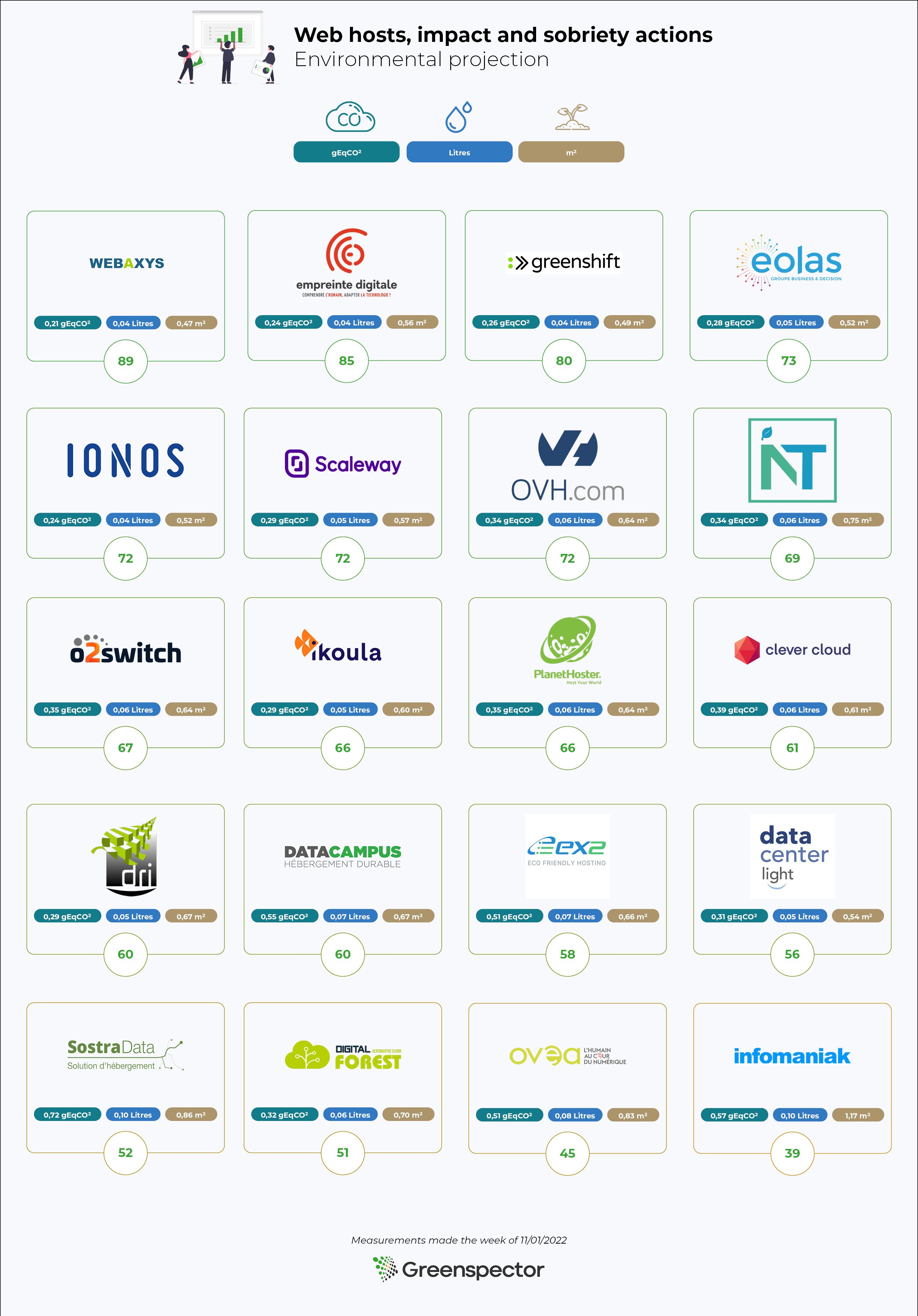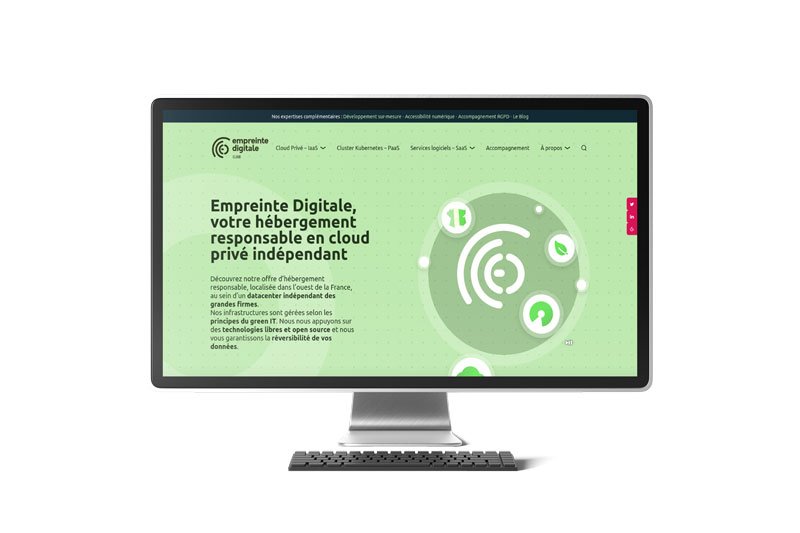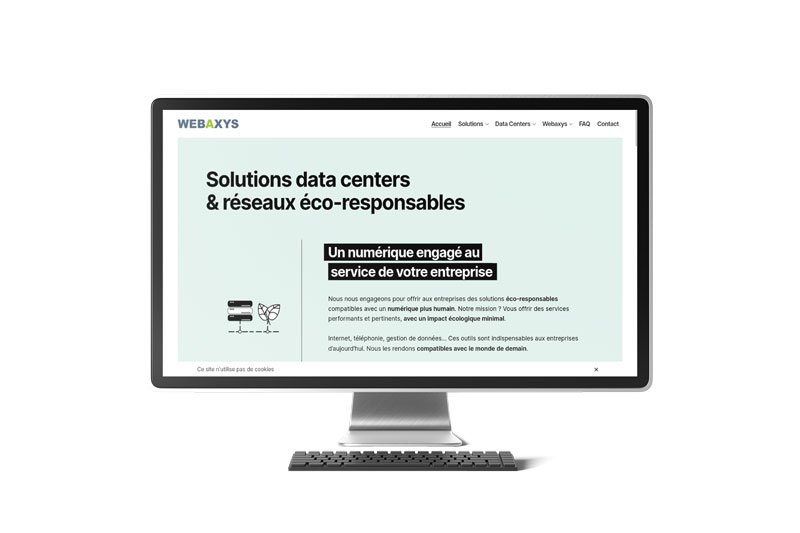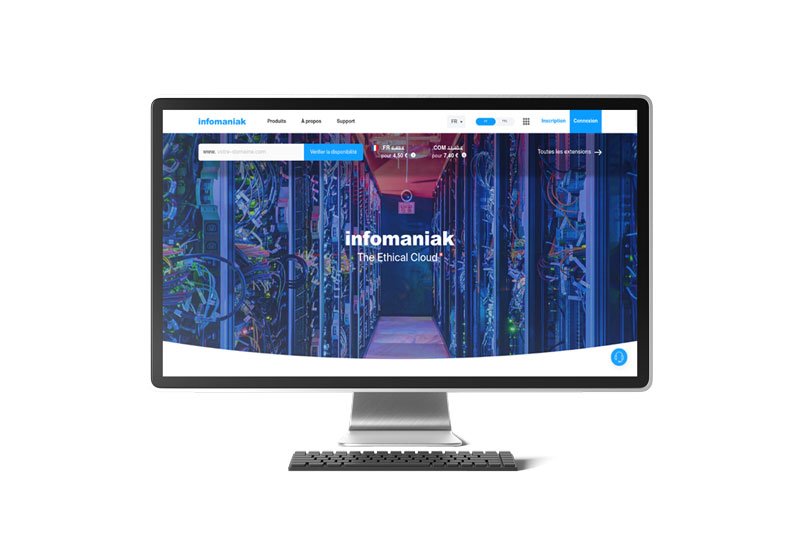Web hosts, impact and sobriety actions
The article is based on measurements taken in November 2022. It is possible that some companies have since redesigned their websites.
Summary of the article
More and more web hosting providers are claiming to be environmentally friendly.
– We measured the homepage of 21 web hosting providers.
– We analysed the homepage of the first ranked provider, which is Digital Footprint.
– We then analysed the homepage of the last one in the ranking which is Infomaniak.
– We then took a look at Greenshift’s site by exposing an extract of the HTTP requests of the homepage.
Finally, we reviewed the good practices of sobriety and accessibility which reveal that Eolas and Empreinte Digitale have the fewest accessibility errors unlike Infomaniak which has the most.
In the next article, we will look at the criteria needed to assess the environmental friendliness of a hosting company.
When we are interested in digital sobriety, the question of the host comes up very often. Indeed, this is a very interesting and cross-cutting lever for reducing the environmental impact of digital services. Things get more complicated when you try to sort out the real from the fake in order to choose the best possible host according to the project’s business constraints. Some providers go so far as to talk about carbon neutrality or even carbon negativity.
Claims of carbon neutrality are most often based on the source of the electricity used according to a market-based (supplier’s claims) or location-based (geographical energy mix) approach. Given that some of the scopes 1, 2 and 3 are often neglected, all of this makes these claims invalid. The purpose of this article is not necessarily to go into this point in detail, but you will find some initial answers here:
- [Youtube, 24min 16s] Carbon footprinting tools for public clouds, a presentation by Pierre Rust from Orange Innovation
- Carbon neutrality’ for digital companies, by EcoInfo
Today, in all cases, the claims of eco-responsibility of hosting providers are mostly based on PUE (Power Usage Effectiveness) and the source of the electricity used. This does not seem to be enough. At Greenspector, we decided to look into the subject, to see what was being offered today and to base ourselves on the existing literature in order to determine what criteria to use to choose a hosting company. We were then able to classify several French (or nearby) hosts.
In this first article, we decided to evaluate the homepage of their sites from the point of view of digital sobriety, in order to check whether they reflect their environmental claims. This approach is of course biased and unrepresentative, but it already gives an idea of where each of them stands from this point of view.
It is only with the second article that we will really be able to decide between the hosts, by sifting through the criteria we have chosen.
Comparison of home pages
Based on their intentions regarding environmental impacts, 21 accommodation providers were selected. We have selected as a priority those that show efforts to reduce the environmental impacts of the services they offer. We may have missed some. If so, please let us know!
Based on this list, we measured the homepage of each with the Greenspector tool in order to compare them.
| Nom | URL | Ecoscore | Energie (mAh) | Données transférées (Mo) | Requêtes HTTP |
|---|---|---|---|---|---|
| Webaxys | https://webaxys.fr/ | 89 | 4,173192 | 0,47913 | 21 |
| Empreinte Digitale | https://cloud.empreintedigitale.fr/ | 85 | 5,009883 | 0,313111667 | 18 |
| Greenshift | https://www.greenshift.co/fr/ | 80 | 4,253108 | 1,079741667 | 51 |
| Eolas | https://www.eolas.fr/ | 73 | 4,449822 | 1,416203333 | 59 |
| IONOS | https://www.ionos.fr | 72 | 4,586076 | 0,9967127 | 27 |
| Scaleway | https://www.scaleway.com/ | 72 | 5,083758 | 2,247849663 | 29 |
| OVH | https://www.ovhcloud.com/fr/ | 72 | 5,553175 | 1,832020334 | 64 |
| Neutral IT | https://neutral-it.com/ | 69 | 6,62236 | 1,286239 | 49 |
| o2switch | https://www.o2switch.fr/ | 67 | 5,3824 | 0,979763667 | 90 |
| Ikoula | https://www.ikoula.com/ | 66 | 5,315384 | 1,54606967 | 33 |
| PlanetHoster | https://www.planethoster.com/ | 66 | 5,469159 | 1,778474 | 76 |
| DRI | https://www.dri.fr/ | 60 | 5,98907 | 0,451148333 | 27 |
| Datacampus | https://datacampus.fr/ | 60 | 5,691275 | 13,14124667 | 64 |
| EX2 | https://www.ex2.com/ | 58 | 5,474202 | 9,756049 | 91 |
| Data Center Light | https://datacenterlight.ch/ | 56 | 4,686341 | 2,86276037 | 51 |
| Sostradata | https://www.sostradata.fr/ | 52 | 7,235153 | 17,19431033 | 89 |
| Digital Forest | https://digitalforest.fr/ | 51 | 6,225642 | 0,897602 | 35 |
| OVEA | https://www.ovea.com/ | 45 | 7,01255 | 4,253318032 | 111 |
| Infomaniak | https://www.infomaniak.com/ | 39 | 10,30043 | 3,092772997 | 72 |
Résultats des mesures sur les pages d’accueil

Now let’s look in more detail
In terms of the Ecoscore (whose calculation methodology can be found on the Greenspector blog), the Webaxys home page does best and Infomaniak does worst. For Infomaniak, this can be explained by the fact that the energy impact of the site is very high. It is even the highest in the sample. On the other hand, from this point of view, it is once again Webaxys that comes out on top. Empreinte Digitale presents the lowest volume of transferred data while Sostradata transfers the most (more than 17 MB!). Concerning HTTP requests, the home page of Empreinte Digitale uses the least while the one of OVEA has the most (at first sight, some optimizations would be quite easy to implement by avoiding duplicates and by delaying the loading of the chat or even by questioning its relevance).
The home pages of the Webaxys and Empreinte Digitale sites clearly stand out and we will now analyze them in more detail. We will then complete our analysis with a quick look at the elements of the Infomaniak site that make it more impactful. We’ll finish with a brief overview of the other sites.
Empreinte Digitale

This homepage is particularly light, which is an opportunity to note the application of several good practices:
- Optimised and lazy-loaded images
- Third-party services mastered and, in principle, all self-hosted
- Very little JS and CSS
- Use of system fonts only
The site is pleasant and attractive. The score could be even better without the animation but this is absent on mobile. The choice of dithering for some images highlights the desire to produce a site as light as possible but is not necessarily necessary.
Webaxys

We find here light and lazy-loaded images, with a simple and attractive service.
On this type of very optimized and light site, some flaws stand out even more, especially the use of Google fonts.

Here we see 7 requests only for these fonts whereas a system font would probably have been suitable. It should also be remembered that their use from Google servers may pose a problem with respect to the RGPD. A variable font could limit the number of files and a subset (limit to useful characters) could reduce the size. But the priority would be to use a system font.
Finally, the last request of the list is probably FontAwesome. So here we get an icon font while only a few icons are useful (and could be integrated in optimized SVG, maybe even directly in the HTML).
Infomaniak

The Infomaniak site stands out for its low Ecoscore and high energy impact.
If you take a closer look, you’ll notice that most of the weight of the page is due to numerous JS files (about forty in all!).
In addition, the animation at the top of the page (for the search of a domain name) seems to be one of the causes of the overconsumption of energy, highlighted in the Greenspector tool:

Other possible explanations for this over-consumption may be found in JS processing. In any case, it should be analysed and limited.
Other websites
Greenshift’s homepage shows a low energy impact, despite the inclusion of animations when the page is loaded. However, in terms of usability, the presence of horizontal scrolling on mobile phones is not ideal.
For the Sostradata site, which has the highest volume of data transferred in the sample, a quick glance reveals the first areas of improvement:
- Avoid including a Google Maps component directly on the homepage
- Optimise images (size, format, quality, lazy-loading)

Good practice in digital sobriety
In terms of good practice, it is worth noting that the Neutral IT homepage meets the most criteria.
From this point of view, we found that some good practices are almost never implemented on the pages in our sample. To improve impact, one should systematically consider :
- Do not let the browser resize images, this limits the consumption of terminal resources
- Only download the necessary images and do lazy loading
- As far as possible, do not integrate css and js code into HTML files; this will avoid systematically reloading the whole file if necessary
- And of course, once the css and js files are independent, they should be minified to save space
Best practices for accessibility
In addition to measurements and verification of good practices (two complementary approaches that are difficult to separate), we were curious to briefly evaluate the selected sites from the perspective of accessibility. While it is important to reduce the environmental impact of digital services, this cannot be done without ensuring that the site adapts to all contexts of use so as not to exclude anyone. What is the point of having the least impactful site possible if it is unusable for a part of the population?
As we do not wish to be exhaustive, we have relied on the aXe tool (it should be remembered that this type of tool is not intended to cover all the WCAG or RGAA criteria) and on the manual verification of certain criteria (200% zoom, content linearisation, textual alternatives, etc.) In accessibility as in digital sobriety, there is no magic wand!
In the end, our findings are as follows:
- The Eolas and Empreinte Digitale websites have the fewest accessibility errors
- Despite its reduced environmental impact, the Webaxys site has several errors that are fairly easy to fix.
- The Infomaniak site is among the sites with the most errors
- Among the most frequent errors, we find mainly those highlighted by the WebAIM Million study (which is consistent):

So here we see (once again) that accessibility and digital sobriety are linked. It would be difficult to say that those who do not take care of the sobriety of their websites do not care about accessibility (and vice versa). On the other hand, it is important to remember that it will be all the easier to apply accessibility criteria to a sober site, and even more so when the two approaches are carried out jointly throughout the project’s life cycle.
Conclusion
A first quick analysis of the websites of the selected hosting providers allows us to distinguish those who make the effort to create a sober (and accessible) site. While this does not indicate that they are paying attention to reducing the environmental impact of their hosting offers, it will be interesting to see if the trends noted here are confirmed later.
In the next article in this series, we will look at the criteria needed to assess the environmental responsibility of a web host. We will return to the websites of the selected hosts to see how each one measures up against the criteria in question.

After working for more than 15 years in web development, Laurent Devernay became a technical consultant in responsible digital technology at Greenspector. When he is not coaching organizations on the eco-design of their digital services, he teaches courses on digital sobriety technologies.
